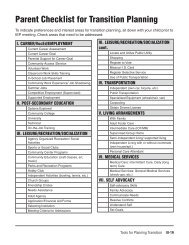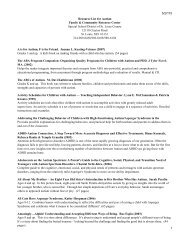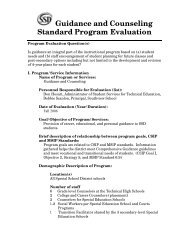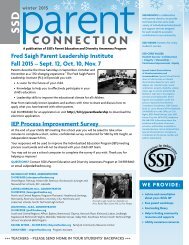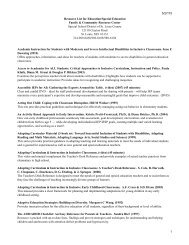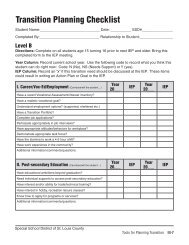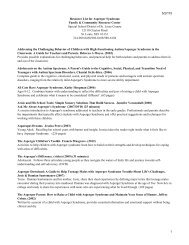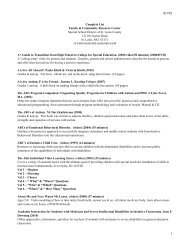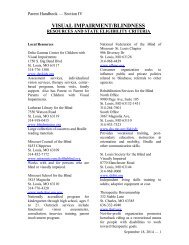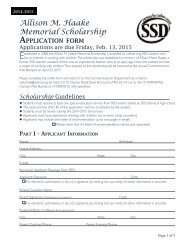Inclusive Education (PDF) - Special School District
Inclusive Education (PDF) - Special School District
Inclusive Education (PDF) - Special School District
You also want an ePaper? Increase the reach of your titles
YUMPU automatically turns print PDFs into web optimized ePapers that Google loves.
Delicate Threads: Friendships Between Children With and Without <strong>Special</strong> Needs in <strong>Inclusive</strong> Settings. DebbieStaub (1998)Culmination of the author's years of careful observations of friendships between seven pairs of children-each including achild with a moderate to severe disability-who are classmates in an inclusive elementary school.6/1/15Departing Rosewood. (video)Film captures the challenges, hopes and transformations that occur as Steven departs the Rosewood Center and creates a lifein the community with new opportunities and new experiences. (DVD)Designing Personalized Learning for Every Student. Dianne Ferguson, et al (2001)This book proposes a systemic-change framework that structures change efforts at district, school, and classroom levels.Different Speeds & Different Needs: How to Teach Sports to Every Kid. Gary Barber (2010)The comprehensive guide to establishing and sustaining inclusive sports programs that welcome students with a wide rangeof special needs.Differentiated Instruction in the Regular Classroom: How to Reach and Teach All Learners, grades 3-12. DianeHeacox (2001)Guide presents a menu of strategies for any teacher faced with a spectrum of student needs and styles.Differentiated Teaching & Learning in Heterogeneous Classrooms: Strategies for Meeting the Needs of All Students.Robi Kronberg & Jennifer York-Barr (1998)Provides conceptual as well as practical information for k-12 educators who want to increase their repertoire of curricularand instructional strategies in order to more effectively meet the needs of all learners in heterogeneous classrooms.Disability Awareness: 24 Lessons for the <strong>Inclusive</strong> Classroom. (1998)Designed for use in an inclusive classroom, peer support program, or a volunteer program, this reproducible book showsstudents how to recognize and act with sensitivity toward those who are different from themselves.Disability is Natural: Revolutionary Common Sense for Raising Successful Children with Disabilities. Kathie Snow.(2001)Disability, like gender, ethnicity and age- are simply one characteristic of being human. There have been people withdisabilities in the world, and there will always be. When we recognize that disability is a natural condition of the humanexperience, new attitudes will lead us to new actions!Discover the Possibilities: A Curriculum for Teaching Parent About Integration (1993).Written to provide vision, information and strategies for the inclusion of children with disabilities into general educationclasses. Provides definition and provides a model to train parents, educators and other to the possibilities and the vision ofdesirable futures for the children.Don't We Already Do Inclusion? 100 Ideas for Improving <strong>Inclusive</strong> <strong>School</strong>s. Paula Kluth. (2013)Practical and engaging how-to book on creating inclusion. Focuses on teachers, staff, principals, district and communitymembers, reminding us that inclusion, as with all social justice, is about joint action and commitment.Each Belongs: The Remarkable Story of the First <strong>School</strong> System to Move to Inclusion. Jim Hansen. (2006)Collection of history - including an extensive collection of documents and letters from teachers and families - that tell thestories of the struggles from the inside over 30 years. Includes DVD.Early Childhood Inclusion: Focus on Change. Michael J. Guralnick (2001)Comprehensively evaluates early childhood inclusion over the past 25 years.Educating Children with Multiple Disabilities A Trans-disciplinary Approach. Fred P Orelove (1996)Educators and service providers will find a clear, practical explanation of how they can integrate their specialized skills toimprove education for learners with severe cognitive and physical disabilities.5
6/1/15Effective <strong>Inclusive</strong> <strong>School</strong>s: Designing Successful <strong>School</strong>wide Programs. Thomas Hehir. (2012)Presents lessons learned from in-depth case studies of some of our most effective inclusive public schools. The authorsconclusively demonstrate that schools can educate students with mild and severe disabilities in general education classroomsby providing special education services that link to and bolster general education instruction.Facilitation for Inclusion with PATH & MAPS. (video) (80 minutes)Companion for The PATH & MAPS Handbook: Person-Centered Ways . Contains a demonstration MAP for a young manand a demonstration PATH with an organization. (DVD)The Foundations of <strong>Inclusive</strong> <strong>Education</strong>: A Compendium of Articles on Effective Strategies to Achieve <strong>Inclusive</strong><strong>Education</strong>. Diane Lea Ryndak & Douglas Fisher, Editors (2003)Includes some of the most impressive articles about inclusive education that have been published in recent years. Thecompendium includes articles from the first edition and newly added articles.Friends & Inclusion. Peggy Hutchison, John Lord & Karen Lord. (2010)Peggy, John & Karen describe their personal search and exploration of five approaches to building the good life that Karenenjoys.Friends at <strong>School</strong>. Rochelle Bunnett (1995)Ages 4-8. Shows that given the opportunity, children readily accept each other's differences. Emphasizes in a relaxed, naturalway that even though some children may look different and have different abilities, all children like to do the same things (29pages)From Behind the Piano: The Building of Judith Snow’s Unique Circle of Friends. Jack Pearpoint (1993)A description of the evolution of friendships and the Joshua Committee including Judith Snow, Marsha Forest, JackPearpoint and friends.From Disability to Possibility. Patrick Schwarz (2006)Illustrates, through stories of struggle and success, how creative, conscientious teachers can work with everyone involved ina student's learning to make special education work.From Possibility to Success: Achieving Positive Student Outdomes in <strong>Inclusive</strong> Classrooms. Patrick Schwarz (2013)Offers templates and authentic forms that help you plan lessons and units while at the same time embracing students' interestsand passions, working toward students' dreams, promoting leadership, self-advocacy, self-determination, and membership inboth school and the community.Get Out, Explore, and Have Fun: How Families of Children with Autism or Asperger Syndrome Can Get the Mostout of Community Activities. Lisa Jo Rudy (2010)Includes hints and tips for involving your family in the right community activities, as well as, suggestions about howorganizations can successfully include children on the spectrum in their activities.How Big is the Fly? Asking the Right Questions. Bonnie Jean Smith (2007)Strategies for communication with students and children.How Can I Be A Good Friend to Someone With Autism / Choosing to Be A GFF (Good Friend Forever). (video) (2films, 16 minutes each)Grades K-5 & 6-8. Two films that promote autism awareness and acceptance by showing students what it is like for theirpeers with autism and how they can interact with them. (DVD)How Can We All Play? Severe disAbility in PE. (video) (2002) (35 minutes)Witness first-hand what the staff at Grant Wood Elementary has put together over the past 15+ years with input from staff,consultants, retirees, PE teachers, families, and students to create fun, safe multi-sensory activities and equipment thatencourage a friendly, positive environment where students of all abilities can and want to play together and become friends.(DVD)6
6/1/15How Katie Got a Voice, and a Cool New Nickname. Patricia L Mervine. (2012)<strong>School</strong> aged. Katie has significant physical disabilities which make her dependent on a Personal Care Assistant foreverything, even communicating. When Katie is introduced to assistive technology, she is finally able to communicate withher new friends. As a result, the students are delighted to see her as a person with many interests and abilities, just like them.(40 pages)How to Differentiate Instruction in Mixed Ability Classrooms. Carol Ann Tomlinson (1995)Provides practical guidance in addressing the diverse needs of students. It offers multiple approaches to content, process andproduct, and is a blend of whole-class, group and individual instruction.How to Reach & Teach All Students in the <strong>Inclusive</strong> Classroom. Sandra Reif (1996)Ready-to-use strategies, lessons and activities for helping students with diverse learning styles, ability levels, skills andbehaviors.I Am <strong>Special</strong>: Introducing Children and Young People to their Autistic Spectrum Disorder. Peter Vermeulen. (2000)Workbook designed for a child to work throught with an adult . The first is an introduction which explains how to informchildren that they have autism or Asperger Syndrome and how to use the worksheets with groups or individuals. The secondpart consists of a series of worksheets which the child works through with an adult to create a personal book about him orherself.IEP and Inclusion Tips for Parents and Teachers. (2006)This book features 127 tips focusing on IEP and inclusion processes. Written from the parent perspective, look at inclusionresearch and practice that help students succeed in and out of school.Including People with Disabilities in Faith Communities: A Guide for Service Providers, Families andCongregations. Erik Carter (2007)A congregational community is an ideal place to share and strengthen faith, form lasting relationships, and develop specialgifts and talents. Too often, though, people with developmental and other disabilities lack the opportunities and supports tofully participate in the life of their faith community.Including Samuel. (video) (2008)Chronicles the Habib family's efforts to include Samuel in every facet of their lives. The film also features four other familieswith varied inclusion experiences, plus interviews with dozens of teachers, young people, parents and disability rightsexperts. (DVD)Inclusion. Reed Martin J.D. (video) (1994) (70 minute)Part of Legal Challenges in <strong>Special</strong> <strong>Education</strong> series from national authority on special education law.Inclusion and <strong>School</strong> Reform: Transforming America's Classrooms. Dorothy Lipsky & Alan Gartner (1997)Gives a solid understanding of the process of school reform and a vision for the 21st century.The Inclusion Facilitator's Guide. Cheryl Jorgensen, et al (2005)Inclusion facilitators are educators who do more than teach children with disabilities—they advocate for change in schoolsand communities, sparking a passion for inclusion in teachers, administrators, and families and giving them the practicalguidance they need to make it work.Inclusion: 450 Strategies for Success—A Practical Guide for All Educators Who Teach Students with Disabilities.Peggy Hammeken (2005)Resource is written for general and special educators and includes simple step-by-step guidelines and hundreds of practicalteacher-tested strategies that are numbered for easy reference.Inclusion: A Fresh Look — Practical Strategies to Help All Students Succeed. Linda Tilton (1996)Classroom ideas to help students participate and progress in the general educational curriculum.7
Inclusion: A Guide for Educators. Susan Stainback & William Stainback (1996)Comprehensive guide gives teachers the tools and techniques needed to support inclusion in the classroom.6/1/15Inclusion in Secondary <strong>School</strong>s: Bold Initiatives Challenging Change. edited by Daniel D. Sage (1997)Contains written record of the experiences of 23 authors who describe a variety of experiences with inclusive efforts at thesecondary level.Inclusion 101: How to Teach All Learners. Anne Bauer & Thomas Shea (1999)This book is designed to help educators provide effective instruction to students with disabilities in inclusive classrooms.The Inclusion Papers: Strategies to Make Inclusion Happen. Jack Pearpoint & Marsha Forest (1992)Resource for conferences, courses and workshops with articles on circles of friends, MAPS, students at-risk and more.Inclusion: A Practical Guide for Parent — Tools to Enhance Your Child's Learning. Lorraine O. Moore (1996)Book serves as a guide to answer parent’s questions and provide them with the necessary tools to promote their child'slearning.Inclusion: Recent Research. Gary Bunch & Angela Valeo (1997)Summaries of research on inclusion in education. Knowledge base for anyone involved in education.Inclusion Strategies for Students with Learning and Behavior Problems: Perspectives, Experiences and BestPractices. Paul Zionts Ed. (1997)This book presents discussions of the practical implementation of inclusion principles with students having learning and/orbehavioral problems and disorders.Inclusion Strategies That Work for Adolescent Learners. Toby J Karten (2009)Helps teachers focus on teaching and learning for results using a wide variety of strategies, including differentiatedinstruction, universal design for learning, brain-based learning, response to intervention (RTI) and evidence based practices.Inclusion Strategies That Work! Research-Based Methods for the Classroom. Toby Karten (2004)Whether you are a general or a special education K-12 teacher, this guide helps you understand and implement hands-onstrategies for successful classroom inclusion of students with disabilities.Inclusion: Strategies for Working With Young Children: A Resource Guide for Teachers, Childcare Providers andParents. Lorraine Moore (1997)This publication includes hundreds of child-focused strategies and activities.Inclusion of Students with Autism: Using ABA-Based Supports in General <strong>Education</strong>. Joel Hundert. (2009)Covers assessment and planning for inclusion, principles of instruction, facilitating communication, promoting peerinteraction, and collaboration with families.<strong>Inclusive</strong> and Heterogeneous <strong>School</strong>ing: Assessment, Curriculum and Instruction. Mary A. Falvey (1995)Contains tools and techniques to help teachers create educational environments where all students have an equal opportunityfor academic and social growth.<strong>Inclusive</strong> Classrooms From A to Z: A Handbook for Educators. Gretchen Goodman (1994)Helps primary teachers move step-by-step toward creating more inclusive classrooms by giving practical guidance toteachers; providing background information on inclusion; offering hands-on activities and strategies for immediateimplementation; and answering the ten questions most frequently asked.<strong>Inclusive</strong> Elementary <strong>School</strong>: Recipes for Success. Douglas Fisher, et al (2004)This book walks readers through a step-by-step process to determine what and how to teach elementary students withdisabilities in general education classrooms.8
<strong>Inclusive</strong> High <strong>School</strong>s: Learning From Contemporary Classrooms. Douglas Fisher, Caren Sax & Ian PumpianAddresses both processes and outcomes and provides a framework for developing inclusive high schools.<strong>Inclusive</strong> Middle <strong>School</strong>s. Craig Kennedy, PhD & Douglas Fisher, PhD (2001)For middle school educators and administrators. Provides practical information they need to bring successful inclusionpractices into their schools.<strong>Inclusive</strong> Programming for Elementary Students with Autism. Sheila Wagner (1999)Provides on inclusion program for students with disabilities. Each inclusion program must be developed individually, witheach student's abilities and characteristics as the guiding factor for the program<strong>Inclusive</strong> Programming for Middle <strong>School</strong> Students with Autism/Asperger's Syndrome. Sheila Wagner (2001)Covers everything from academic requirements and homework issues to social conflicts, such as dress codes and raginghormones.<strong>Inclusive</strong> <strong>School</strong>s In Action: Making Differences Ordinary. James McLeskey & Nancy Waldron (2000)The nuts and bolts of creating an inclusive school from authors who share their wisdom and practical advice aftersuccessfully integrating inclusion into 50 schools.6/1/15Individualized Learner Outcomes: Infusing Student Needs Into the Regular <strong>Education</strong> Curriculum. Janet Filbin et al(1996)Manual developed to provide educators with a process to integrate the lifelong goals and specific needs of students with themost severe disabilities within the context of the regular education curriculum through the development of individualizedlearner outcomes.Inspiring Active Learning: A Handbook for Teachers. (1994)Practical, commonsense strategies many teachers have successfully used to help students become active, responsible learners.Integrating Differentiated Instruction and Understanding by Design: Connecting Content and Kids. Carol AnnTomlinson & Jay McTighe (2006)Two models converge: crafting powerful curriculum in a standards-dominated era and ensuring academic success for the fullspectrum of learnersInto the Mainstream. (video) (27 minutes)Ivonne, a nine year old who happens to be blind, narrates a year of her life in Manhattan with grace, courage, and humor.(DVD)Joyful Learning: Active and Collaborative Learning in <strong>Inclusive</strong> Classrooms. Alice Udvari-Solner & Paula KluthPromoting the concept that learners with differing abilities can learn side by side, this book illustrates how to use a practical,differentiated approach to help develop every student's abilities.Just Because. Rebecca Elliott. (2010)Ages 5 and up. A younger brother describes all the fun he has with the big sister he loves so much—just because, in thisheartwarming picture book about being perfectly loved, no matter what.Last One Picked…First One Picked On: Learning Disabilities and Social Skills. Rick Lavoie (video) (2005) (60minutes)Playing with friends usually is a happy ritual for most children. But kids with learning disabilities are often isolated andrejected. This program addresses the social problems these children face - and offers some practical solutions. (DVD)Leadership Strategies for Successful <strong>School</strong>wide Inclusion: The Star Approach. Dennis Munk & Thomas Dempsey(2010)Gives school leaders a clear framework for leading inclusion efforts, monitoring their success, and facilitating consistent useof best practices.9
6/1/15Leaving the Door Open: Alternatives to Seclusion and Restraint. (video)This training video has been developed to help facilities reduce and ultimately eliminate the use of seclusion and restraintpractices in institutional and community settings. (DVD)Lesson Plan a la Carte. Valerie Paradiz, Todd Germain, Sarah Olivieri & Michelle DeFelice Haverly. (2012)Guides educators through a simple, step-by-step process of creating an integrated lesson plan that addresses the social,environmental and communication challenges that block kids access to academics and other learning opportunities.Listening To the Experts: Students with Disabilities Speak Out. Elizabeth B. Keefe, Ph.D., Veronica M. Moore,Ph.D., & Frances R. Duff (2006)What’s the best way to find out what really works — and doesn’t work — in education for students with disabilities? Listento the experts: the students themselvesMaking a Difference: A Guidebook for Person-Centered Direct Support. John O’Brien & Beth Mount (2005)Strategies for various support systems for individuals with special needs.Making Inclusion Work. Anne M. Beninghof (Facilitator’s guide and video) (1999) (60 minutes)For grades K-6. Develop your inclusion skills with this video of practical strategies for teaching diverse learners, effectivecollaborative teaching methods and planning guidelines.Making Inclusion Work for Students with Autism Spectrum Disorders: An Evidence-Based Guide. Tristam SmithPresents a research-based, step-by-step process for assessing students at a range of skill levels, planning and implementingsuccessful inclusion programs, and working as a team with other professionals and with parents. The book is packed withspecific strategies for helping students with ASD follow the daily routine, learn from the general education curriculum,interact with peers, and overcome problem behavior.Making <strong>School</strong> and Community Recreation Fun for Everyone: Places and Ways to Integrate. edited by M. SherrilMoon (1994)Text is packed with practical and easy-to-implement strategies for integrating individuals with disabilities into summercamps, school clubs and teams, park and recreation programs, YMCA activities, community theater, and many otheractivities.Making <strong>School</strong> Inclusion Work: A Guide to Everyday Practices. Katie Blenk (1995)Shows how inclusion works at Kids Are People <strong>School</strong> and shares suggestions for dealing with the myriad of challengesposed by the goal of inclusion.Meeting the Needs of Students of All Abilities: How Leaders Go Beyond Inclusion. Colleen A. Caper, et al (2000)This book helps us to recognize the spirit of the inclusion laws and explains how to create educational environments forstudents that are academically appropriate, culturally sensitive and compassionately caring.Miller’s MAP. Marsha Forest & Jack Pearpoint (video) (1992) (40 minutes)A moving and practical teaching tool that shows how to make inclusion happen with a children, parents, neighbors andprofessionals working as a creative team. (DVD & VHS)Modifying <strong>School</strong>work: Teachers Guides to <strong>Inclusive</strong> Practices. Rachel Janney & Martha E Snell (2013)Packed with field-tested strategies, case studies, and planning tools, this hands-on guide will help teachers deliver effectiveuniversal instruction in core content areas and create customized adaptations and flexible supports for students with diverseneeds and abilities.10
6/1/15More Behavior Solutions In and Beyond the <strong>Inclusive</strong> Classroom: A Must Have for Teachers and Other <strong>Education</strong>alProfessionals. Beth Aune, Beth Burt & Peter Gennaro (2011)This book builds on the success of the first one by expanding the focus from within the classroom to all areas of the schoolenvironment—in the hallways, cafeteria, and auditorium, on the playground, and in therapy sessions during the school day.More Than Shared Classrooms: Educating Kids With and Without Disabilities Together Successfully. MichaelRemus & Bev Adcock (1998)A great primer about how to make an inclusive educational environment work. Gives real life examples of adaptation,modification and what IDEA really means.Moving to Middle <strong>School</strong>: Life Skills and Coping Skills for Successful Student Transition. Melodie Wenz-Gross, etal (2002)This unique program is based on six years of research conducted at the University of Massachusetts showing that studentsexperience increased stress during transition into middle school, not only in academics, but in their relationships with peersand teachers.Natural Supports in <strong>School</strong>, at Work and in the Community for People with Severe Disabilities. Jan Nisbet (1992)Offers new paradigms for natural supports in school, at work, and in the community.New Directions in <strong>Special</strong> <strong>Education</strong>: Eliminating Ableism in Policy and Practice. Thomas Hehir (2008)Examines the ways that cultural attitudes about disability systematically distort the education of children with special needsand uses this analysis to lay out a fresh approach to special education policy and practice.New Friends: Mainstreaming Activities to Help Young Children Understand and Accept Individual Differences.Designed to use with pre-school and kindergarten children to help them understand and accept individual differences. It isdesigned so teachers may expand regular classroom experiences to include positive role models of children and adults withdisabilitiesNew Life in the Neighborhood: How Person with Retardation or Other Disabilities Can Help Make a GoodCommunity Better (video)Out and About: Preparing Children with Autism Spectrum Disorders to Participate in their Communities. JillHudson & Amy Bixler Coffin (2007)Focus is on the every day, how to enable and support individuals on the autism spectrum to participate, to the maximumextent possible, in the community around them.Out of My Mind. Sharon M Draper. (2011)Ages 10 and up. Melody cannot walk or talk, but she has a photographic memory; she can remember every detail ofeverything she has ever experienced. She is smarter than most of the adults who try to diagnose her and smarter than herclassmates in her integrated classroom—the very same classmates who dismiss her as mentally challenged, because shecannot tell them otherwise. But Melody refuses to be defined by cerebral palsy. And she’s determined to let everyone knowit…somehow. (320 pages)The PATH & MAPS Handbook: Person-Centered Ways to Build Community. John O'Brien, Jack Pearpoint &Lynda Kahn. (2010)Provides a strong foundation for path and maps by connecting person-centered planning to the work of community building.The handbook is divided into two parts : think about it and do it.PATH In Action: Working with Groups & PATH Training Video. (video)Teaching video which illustrates two Paths with two groups planning the future of a school system. (DVD) (65 min & 31min)Path: A Workbook for Planning Positive Possible Futures. Jack Pearpoint, et al (1993)A guide to exciting, creative, colorful futures planning for families, organizations and schools to build caring "including"places to live, work & learn.11
6/1/15Peer Buddy Programs for Successful Secondary <strong>School</strong> Inclusion. Carolyn Hughes & Erik Carter (2008)Gives schools step by step guidance they need to get a peer buddy program started and keep it going.Peer Tutoring and Support: Making <strong>Inclusive</strong> <strong>Education</strong> Work- Creating <strong>School</strong>s that Benefit Everyone. RebeccaBond-Brooks & Elizabeth Castagnera (2010)Practical strategies that provide students with disabilities access to general education curriculum, to typical school-wideactivities, and to rich opportunities to learn alongside peers without disabilities.Person Centered Planning with MAPS and PATH. John O’Brien & Jack Pearpoint (1993)This new book was developed over time as a collection of handouts for our three-day course teaching MAPS and PATH.Positive Behavioral Support: Including People with Difficult Behavior in the Community. Lynn Kern Koegel et alStrategy-packed resource demonstrates how people with challenging behavior can be fully included at home, in school and inthe community.The Power of 2 (2 DVD Set and Facilitator Manual) (2005)Provides a comprehensive look at co-teaching as part of the foundation of an inclusive and collaborative school.Power to Spring Up: Postsecondary <strong>Education</strong> Opportunities for Students with Significant Disabilities. DianaKatovitch (2009)Guide profiles the many different types of postsecondary options available, ranging from a modified academic program on auniversity campus, to a vocational residential program designed specifically for students with special needs.Practical Strategies for High <strong>School</strong> Inclusion of Students with Behavioral Disabilities. Dr. June Stride (2004)All high school students want to feel they belong and this is particularly true of students with an ED label. Veteran specialeducator and author June Stride writes candidly about her challenges, frustrations and disappointments from her experienceas a teacher and department head.Practical Strategies for Middle <strong>School</strong> Inclusion. Eileen Bowers (2004)An inclusion teacher for many years shows how to put together an inclusive program that works for everyone involved, fromthe administration to the students. Bowers recalls her struggles and also the successful strategies she developed.A Principal's Guide to Creating a Building Climate for Inclusion. Teresa Van Dover (1995)Guide written to serve as a tool for those in building-level leadership positions. Provides an educational foundation,comprehensive presentations and follow-up activities that can be used to assist faculty members in exploring issues related toinclusion of students with disabilities in general education classrooms.The Principal's Handbook for Leading <strong>Inclusive</strong> <strong>School</strong>s. Julie Causton & George Theoharis (2013)Covering everything from the basics of special education to the everyday nuts and bolts of making inclusion work, tworenowned inclusion experts give readers clear guidance they can use right away to lead a fully inclusive school where everystudent learns and belongs.Quick-Guides to Inclusion: Ideas for Educating Students with Disabilities. Michael Giangreco (2007 – second edition)Offers essential information in a short amount of time for busy teachers and administrators. Gives easy-to-follow tips, ideas,examples and suggestions to make inclusion work in the classroom.Real Work for Real Pay: <strong>Inclusive</strong> Employment for People with Disabilities. Paul Wehman et al (2007)Aimed primarily at employment services personnel, this volume describes strategies, tools, and techniques for promoting thefull employment of individuals with disabilities.Rediscovering MAPS: Charting Your Journey & New MAPS Training Video: Shafik's MAP. (video)Segments of two MAPS processes are used to provide support and instruction to people concerned with excellence andintegrity in person centered planning. (DVD) (73 min & 35 min)12
6/1/15Reflections of Erin: The Importance of Belonging, Relationships and Learning with Each Other. Barbara McKenzie(2008)Conveyed in the form of keen observations, heartfelt surprises, and insightful reflections, the stories and images inspired byErin McKenzie’s life demonstrate the rich connections and relationships that result from an inclusive learning community.Restructuring High <strong>School</strong>s for All Students: Taking Inclusion to the Next Level. Cheryl Jorgensen (1997)Goes beyond strategies for inclusion and focuses instead on ways to enhance effective general education practices so allstudents experience the social life and academic expectations of high school.Seeing the Charade: What We Need to Do and Undo to Make Friendship Happen. Carol Tashie, et al (2006)This book is aimed at overcoming friendship barriers and the facilitation of friendships in inclusive environments.Social Relationships and Peer Support (Teacher’s Guides to <strong>Inclusive</strong> Practices). Rachel Janney & Martha SnellBook provides general and special educators, school principals, counselors, and related service staff with a bridge frominclusion research to inclusive practice, one subject at a time.The <strong>Special</strong> Needs Acceptance Book: Being a Friend to Someone with <strong>Special</strong> Needs. Ellen Sabin. (2007)Interactive, educational, and character-building book that introduces children to the challenges faced by people with specialneeds while also supporting their personal journey toward appreciating and respecting people's differences.<strong>Special</strong> Needs in the General Classroom: Strategies That Make It Work. Susan Gingras Fitzell. (2010)Shows how to identify, face, and solve the teaching challenges you may experience in an inclusive classroom.SSD <strong>Inclusive</strong> <strong>Education</strong>. (video) (15 minutes)Provides an overview of SSD, parent and partner district perspectives on the strategies that make inclusive educationsuccessful for all children. (DVD)Stars of Inclusion: Beginning with Bong (video) (54 minutes)Grades 3 and up. Enter the world of six kids and forget the medical labels of cerebral palsy, spina bifida, arthrogryposis,spinal cord injury and muscular dystrophy. Ages 8-14, each one has a different story to tell about their life and education inthe mainstream. (DVD)Straight AAA's, All About Autism: Educating Elementary <strong>School</strong>-Age Children About Their Peers with Autism.(video) (2011) (15 minutes)Video program to explain autism to an elementary school classroom. Hosted by Doug Flutie. Approx 15 min. DVDSuccessful Inclusion Strategies for Secondary and Middle <strong>School</strong> Teachers. M.C. Gore (2003)Helps teachers access this specific research targeting students with disabilities in middle school and secondary classrooms.Successful Inclusion for Students with Autism: Creating a Complete, Effective, ASD Inclusion Program. Sonja R deBoer. (2009)Offers step-by-step guidance for creating successful inclusion programs and includes specific information on key topics suchas educator roles and responsibilities, ongoing program assessment, and evaluating student progress.Supporting Students with Disabilities in <strong>Inclusive</strong> <strong>School</strong>s: A Curriculum for Job-embedded ParaprofessionalDevelopment. Gail Ghere (2002)This facilitator's manual is part of a curriculum to help special educators teach paraprofessionals to support individualstudents with disabilities effectively, especially students with moderate to severe disabilities who require individualizedsupportA Teacher's Guide to Including Students with Disabilities in Regular Physical <strong>Education</strong>. Martin E. Block (1994)Practical reference emphasizes the value of a collaborative team approach and provides simple and creative strategies formeaningfully including children with disabilities into regular physical education programs.13
6/1/15The Teacher's Guide to Intervention and <strong>Inclusive</strong> <strong>Education</strong>: 1000+ Strategies to Help ALL Students Succeed.Glynis Hannell (2007)Contains hundreds of practical strategies that will help teachers teach more effectively, work together with colleagues andparents and it provides hundreds of practical tips, tools and teaching techniques to meet the individual needs of all students inthe classroom.Teacher's Survival Guide: The <strong>Inclusive</strong> Classroom. Cynthia G Simpson, Vicky G Spencer & Jeffrey P Bakken.Addresses the most important issues new teachers face when working with students with disabilities, including collaboration,establishing parent relationships, understanding legal issues, and managing the classroom.Teaching Students with Autism & Asperger's Syndrome in the <strong>Inclusive</strong> Classroom. Paula Kluth PhD. (2009)Reference guide to help educators support students with autism, Asperger's Syndrome and related labels in inclusiveclassrooms and schools.Teaching Children with Down Syndrome: A Resource Guide for Educators in Elementary <strong>School</strong>s. Patricia Oelwein(1998)This guide presents a recognized reading program for children with Down syndrome that effectively meets each child'sunique learning needs and style.Teaching Everyone: An Introduction to <strong>Inclusive</strong> <strong>Education</strong>. Whitney H Rapp & Katrina L Arndt. (2012)Text that prepares teachers to see past disability labels and work with all students' individual needs and strengths.Teaching Kids with Learning Difficulties in the Regular Classroom. Susan Winebrenner (2005)Lists practical, easy-to-use teaching methods, strategies, and tips, for teachers to help differentiate the curriculum in allsubject areas to meet the needs of all learners-including those labeled "slow," "remedial," or "LD," students of poverty,English language learners, and others who struggle to learn.Teaching Kids with Mental Health & Learning Disorders in the Regular Classroom: How to Recognize, Understand,and Help Challenged (and Challenging) Students Succeed. Myles L. Cooley (2007)Describes mental health and learning disorders often observed in school children, explains how each might be exhibited inthe classroom, and offers suggestions for what to do (and what not to do).Technology for Inclusion. Mary Male (1997)This text is designed for hands-on practitioners, from beginner to advanced. Written in an informal style, with a strongresearch base, this text will appeal to both preservice and professional in-service audiences.That All May Worship – An Interfaith Welcome to People with Disabilities. National Organization on DisabilityThe purpose of the handbook is to assist congregations, denominational groups and seminaries in welcoming people withdisabilities.Toward <strong>Inclusive</strong> Classrooms. NEA Professional Library (1994)Speaks directly to other teachers about their school restructuring efforts. Covers large-scale school change, studentassessment, cross-age grouping, and including students with disabilities in the regular classroom. Includes ideas on: teaming,recreating the science fair, inclusive writing workshops working with behavioral challenges and more.Toward Successful Inclusion of Students with Disabilities: The Architecture of Instruction. Volume 1: An Overviewof Materials and Adaptations. Edward J. Kame’enui & Deborah C. Simmons (1999)This book offers guidelines for designing the cognitive supports to instructional materials for students with disabilities ingeneral education classrooms.Treasures: A Celebration of Inclusion. Anne Donohue Dillon (1993)Presents photographs and quotations illustrating the effective inclusion of children with disabilities in New Hampshire'spublic schools.14
The Two Faces of Inclusion: The Concept and The Practice. Tape One. (video) (1993) (57 minutes)Viewers will see and hear how inclusion has become a new standard of practice.6/1/15Understanding Sam and Asperger Syndrome. Clarabelle van Niekerk & Liezl Venter. (2006)Ages 5 and up. The book includes 10 helpful tips geared toward children, showing them how to respect and acceptdifferences as well as to interact with a classmate or friend with Asperger Syndrome.Universal Design for Transition: A Roadblock for Planning and Instruction. Colleen A. Thoma (2009)Guidebook that presents information in multiple formats and media to help students achieve academic goals and makeinformed choices about their futureWe ALL Fit: A K-5th Grade Autism Peer Sensitiviy and Bullying Prevention Video. (video) (2014)Grades K-5. With a run-time of 15 minutes plus a reinforcing 4-minute music video by The Figureheads, this professionallyproducedvideo was written with elementary students in mind, but contains information about autism and social emotionallessons valuable to people of any age. (DVD)What Successful Teachers Do: 91 Research-Based Classroom Strategies for New and Veteran Teachers. Neal A.Glasgow, et al (2003)Provides 91 key strategies for improving and re-energizing classroom practice.When Carrots Ruled the World. David LeBarron. (2012)Ages 5 and up. In this quirky story, the carrots welcome everyone, even bunnies, and accept them for being exactly who theywant to be!Who Cares About Kelsey? (video) (2012) (76 minutes)Documentary about empowering, not overpowering, youth with emotional and behavioral disabillities. (DVD)Whole <strong>School</strong> Success and <strong>Inclusive</strong> <strong>Education</strong>: Building Partnerships for Learning, Achievement andAccountability. Wayne Sailor (2002)This collection of papers examines inclusive education practices in public schools.Widening the Circle: The Power of <strong>Inclusive</strong> Classroom. Mara Sapon-Shevin (2007)Argument for creating school and classroom environments where all kids, including children labeled as "disabled" and"special needs," are welcome on equal terms.With Open Arms: Creating <strong>School</strong> Communities of Support for Kids with Social Challenges Using Circle of Friends,Extracurricular Activities and Learning Teams. Mary Schlieder (2007)Kids with Asperger Syndrome, attention deficit disorder, learning disabilities, and behavior disorders, as well as Englishlanguage learners, often face even greater social challenges, resulting in feelings of isolation. Book provides practical, easyto-usetechniques for even the busiest school personnelWonder. R J Palacio. (2012)Ages 8 and up. August Pullman was born with a facial deformity that, up until now, has prevented him from going to amainstream school. Starting 5th grade at Beecher Prep, he wants nothing more than to be treated as an ordinary kid—but hisnew classmates can’t get past Auggie’s extraordinary face.You Can’t Say You Can’t Play. Vivian Gussin Paley (1992)Explores how to keep students from being ignored by their classmates. Weaves a parable about loneliness and rejection,which enables the reader to share a child's view of the world.You're Going to Love This Kid: A Professional Development Package for Teaching Students with Autism in the<strong>Inclusive</strong> Classroom. Paula Kluth. (2011) (video and guide)Hosted by Paula and expanding on key lessons from her bestselling books and popular presentations, the 55-minuteprofessional development video walks you through the what, why, and how of honoring and supporting all learners. (DVD)15
You’re Going to Love This Kid — Teaching Students with Autism in the <strong>Inclusive</strong> Classroom. Paula Kluth (2003)Guide to understanding students with autism and including them fully in the classroom.You’re Welcome: 30 Innovative Ideas for the <strong>Inclusive</strong> Classroom. Patrick Schwarz & Paula Kluth (2007)Three Handbooks with 30 key ideas of information to start making inclusion work effectively,.6/1/1516



